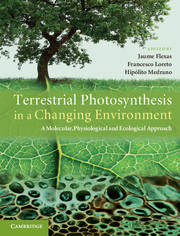 Terrestrial Photosynthesis in a Changing Environment
Terrestrial Photosynthesis in a Changing Environment Published online by Cambridge University Press: 05 March 2013
Introduction
Increasing understanding of the many molecular and biochemical processes that respond in a purposive way to the changing environment has given rise to an appreciation that many, if not all, environmental cues evoke primary responses at a molecular level, and that it is these responses that result in changes in gross plant physiology and morphology. Likewise, changes in the relative proportions of metabolites and ions within intracellular compartments in response to such environmental cues also give rise to multiple changes in gene expression. The interaction between these levels of complexity in response to changes in the external environment is illustrated in Scheme 13.1.
This chapter describes and discusses approaches: (1) for the unbiased analyses of gene, protein and metabolite function facilitated by a variety of high-throughput approaches; and (2) for the focused analyses of specific genes, gene products and metabolites. The former approaches seek to identify hitherto unknown genes and molecular interactions, while the latter are used to probe those elements that we currently consider most important in understanding and interpreting how photosynthetic processes relate to ecophysiological questions. In particular, we discuss aspects of the isolation and assay of the carboxylating enzymes, Rubisco and phosphorenolpyruvate carboxylase (PEPC), owing to their pivotal roles in assimilation and to the continuing interest in their measurement. In general, we have selected methods and approaches that have been applied in our laboratories, but acknowledge that many alternative methods could have been described, which are equally reliable and quantitative.
To save this book to your Kindle, first ensure [email protected] is added to your Approved Personal Document E-mail List under your Personal Document Settings on the Manage Your Content and Devices page of your Amazon account. Then enter the ‘name’ part of your Kindle email address below. Find out more about saving to your Kindle.
Note you can select to save to either the @free.kindle.com or @kindle.com variations. ‘@free.kindle.com’ emails are free but can only be saved to your device when it is connected to wi-fi. ‘@kindle.com’ emails can be delivered even when you are not connected to wi-fi, but note that service fees apply.
Find out more about the Kindle Personal Document Service.
To save content items to your account, please confirm that you agree to abide by our usage policies. If this is the first time you use this feature, you will be asked to authorise Cambridge Core to connect with your account. Find out more about saving content to Dropbox.
To save content items to your account, please confirm that you agree to abide by our usage policies. If this is the first time you use this feature, you will be asked to authorise Cambridge Core to connect with your account. Find out more about saving content to Google Drive.